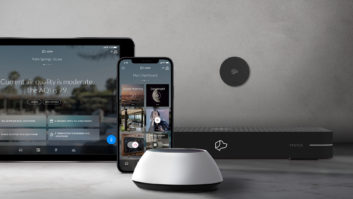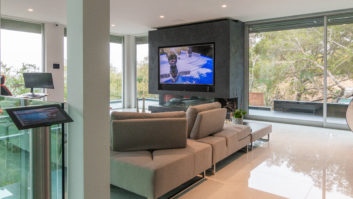Not long ago, there was no such thing as a brand “portal.” When integrators needed to purchase products for their upcoming installations, they likely pulled out a catalog and called their nearest distributor. Or they purchased necessary items through a side deal with a friendly retailer. As an integration company grew, it could finally qualify for a direct account with manufacturers. This new status changed everything, including how products were purchased. Most likely the dealer called up the manufacturer’s sales representative and verbally gave him an order. Or perhaps he faxed or emailed a hard copy of his purchase order to the rep or the manufacturer directly.


In the “Resources & Tools” section of its portal, Vantage has created a whole series of reference designs with completely detailed plans that are optimized for that type of installation.Vantage’s main product portal has an exceptionally clean and uncluttered look with simple, yet straightforward navigation tools
Although not necessarily optimal for integrators, this has been a system that works. But it was also fraught with problems like miscommunications, transposed numbers, and in general, paperwork bottlenecks, often bringing the order process to a halt.
Over the last five years or so, the whole process has changed, as most large suppliers and many smaller ones developed special websites–known as portals–where dealers can research products and place orders. But are these portals really the path to profit? Or are they simply new points of pain? We reviewed the portals of four notable brands and spoke with several integrators to determine what they look for in an effective portal. There is no particular significance to the brands we chose to review, other than that they all have a reputation for well-thought-out designs. Each of these companies–Vantage, Origin Acoustics, Core Brands, and SnapAV–took the task of designing its portals seriously, and the results clearly show that their dealers benefit from that extra effort.
Vantage
We managed to catch Vantage at a bit of an awkward time for a portal discussion, as they are in the midst of developing another iteration of their design. Nonetheless, Vantage director of marketing Reid Cram and marketing coordinator Lindsay Bull were able to show us the design of their current portal and explain where changes are coming. Notably, Vantage was an early adopter of portals, which has allowed it to evolve its design for maximum impact.
“We’ve had online ordering for about five years,” Cram said. “We’re currently on our second generation design and moving into our third generation.”


Unlike the typical start-up company, Origin recognized the need to invest in a complete and detailed dealer portal right at launch last year.
One of the unique aspects of Vantage’s approach is that it employs a separate portal, called the Vantage Prospective Dealer Hire Portal, for those dealers who seek Vantage authorization. The idea is to facilitate an immediate process for a dealer who has been browsing the Vantage website and has decided they want to sign up. No problem. Just enter all of your details into this special portal, which is designed to be super simple with step-by-step input and even a progress bar so you always know where you are in the process. When your information has been completely input, it is forwarded to the appropriate Vantage sales manager to review and approve. Upon that approval, your login credentials are activated.
Vantage’s main product portal has an exceptionally clean and uncluttered look with simple, yet straightforward navigation tools. Dealers can quickly find what they’re looking for by clicking on a list of categories down the left-hand side of the screen and then directly selecting the model they’re interested in.
On the product detail screen, the dealer can see a full description of the item with an expandable image, all related items and accessories, a features list, and on a separate tab, resources such as sales sheets with specifications, image gallery, downloadable drivers, compatibility charts, and more.
Vantage dealers can also order products through its Design Center software–a popular tool that Vantage dealers can use to design systems. This is a parallel option for those dealers who prefer to directly order through this software. For other dealers, the standard Vantage portal remains the best option.
One unique area of site focuses on specific needs related to vertical markets in the AV business. Let’s say you’ve been invited to bid on a museum project (something your firm has never done before) and don’t know where to begin. In the “Resources & Tools” section of the portal, Vantage has created a whole series of reference designs with completely detailed plans that are optimized for that type of installation. Just scroll down to “Museums”…and you’re in business. In no time, you will look like an expert on museum systems to your prospective client.
Vantage VP Cram told us that the company will have a significant update to its portal by the end of this year that will expand the capabilities of their existing system. The new version will add helpful information such as YTD sales and shipment history. Perhaps most visibly, the new portal will be a “responsive” design, which means the visual look of the portal can be optimized for the size of display that dealer is using.
Origin Acoustics
Unlike the typical start-up company, Origin recognized the need to invest in a complete and detailed dealer portal right at launch last year. The Origin portal and its website utilize NetSuite, a popular cloud-based ERP software platform, as its foundation. Origin started by building a very complete website with all of the critical information that a dealer may require to select the correct product for their application. To facilitate the process of locating an item, the site offers a series of cascading menus, where you hover your mouse over a menu and a sub-menu opens up.
Origin’s portal (and website) also uses a search function that includes a feature known as “type ahead” that offers potential result options based on each letter as you type. With these tools, website visitors can quickly navigate through the site to the specific item they want to view.
Origin’s website is packed with a copious amount of content (the same content is available to both dealers and non-dealer visitors to the website.) Once on the product detail page, the website visitor can see an overview description of the item, photos, more information on specific technologies, any instruction or data sheets, videos relevant to that item, ratings and reviews, and a list of related items. To access pricing, programs, and to order items, however, you have to have a dealer login.
“When the dealer logs in, the public site works in conjunction with the portal,” Origin Acoustics CEO Jeremy Burkhardt said, as he walked through a demonstration. “And they can be always logged in.”
Once logged in, several things happen: 1) A new menu bar opens beneath the main menu that allows the dealer access to their account, track an order, see their order history, see a list of favorite items, and to see a saved list of items; 2) A horizontal panel opens on the product detail page underneath the main product overview description, displaying all of the necessary pricing information such as MSRP, wholesale price, the specific dealer’s price (based on their program), and the amount of profit he can earn on that product. On the right-hand side of the page, another panel opens that allows products to be added to a shopping cart in the desired quantity.
The Origin portal allows dealers to select items as “favorites” for easier access on subsequent visits. The portal also allows dealers to create “saved lists” of products that can facilitate future orders.
Origin’s portal is said to possess custom-created algorithms that expands its capabilities, but the company declined to go into details on specifically what these algorithms are or how they work.
“The amount of clicks it takes to get an order placed with us is fewer than anybody else,” Burkhardt said. “With the amount of data on our site, it’s a shopping experience rather than just a shopping cart.”
Core Brands
Much like Vantage, Core Brands has seen its portal go through a few revisions. This newest iteration, premiered with much fanfare during CEDIA 2015, is the company’s most complete offering yet, with a dramatic expansion of features, content, and capabilities.


Core Brands had an even greater challenge in designing its portal because this one interface has to serve the company’s 11 brands.
“We analyzed both what dealers were ordering and how they went about ordering it,” Craig Copley, Core Brands director of business systems, said. “We asked ourselves, what do [dealers] need to do business? Our goal was all about optimizing the portal for the dealer.”
Core Brands had an even greater challenge in designing its portal because this one interface has to serve the company’s 11 brands. With this being the case, after the dealer login, the user can choose to search for products in several ways, including by brand, or by category.
Choosing to search by brand takes you to a brand page that is almost a portal within a portal, with a logical menu structure for the categories of that particular brand. This is a great way for dealers not carrying certain Core Brands lines to see what those other lines offer. All dealers can see all brands, but can only purchase those brands for which they are authorized. Click “Add a Brand” to begin the process of attaining authorization on additional Core Brands lines. Alternatively, you can set the portal to only show those brands that you are authorized for, reducing the number of items that populate a page. Choosing to search by category will show products across the company’s brand spectrum in each category. Choose, for example, to search for 6-inch in-ceiling speakers, and you will see options across their lines.
The search tool is quick and easy, efficiently landing dealers on a very complete product detail page. The product detail page includes tabs that open to an impressive amount of information, including item photos, detailed item description, feature explanations, specifications, warranty information, and website user reviews. The company has gone to great lengths to include a vast amount of content, including detailed architectural drawings and dimensions, downloadable sales sheets, downloadable drivers, and more.
Particularly noteworthy, underneath the tabbed section, the company includes dark gray bars titled Related Items, Recommended Products, Replacement Parts, and Often Bought Together. When you click on one of these gray bars, a new section opens up with content specific to that heading. And as Copley showed us, there was a tremendous amount of helpful content under each of those headings, all designed to answer the most obvious questions a dealer may want to ask. For instance, “I wonder what accessories go with this? (Related Items) I wonder which of these are the best option for me? (Recommended Products) I wonder if I can get a new bracket for one I already have? (Replacement Parts) I wonder what other products I should be considering? (Often Bought Together).
It is important to note that any portal is only as good as the content made available to dealers. On this front, the new Core Brands offering is quite impressive.
SnapAV
SnapAV has been offering a dealer portal longer than most other brands, launching its first version almost 10 years ago. Unlike most brands, SnapAV does not rely on a national sales rep network nor outside distributors to sell its products to dealers. Therefore, the portal is its key selling tool.
The company recognized early on that an effective portal was much more than just an order point, and through steadily evolving design iterations it has virtually perfected the art and science of presenting and selling custom integration products. For this reason, SnapAV’s portal is considered by many to be the reference standard of excellence in portal design. About 30 seconds into a walk-through of the portal by SnapAV senior VP Adam Levy, it became clear why.


While other brands may offer a typical product sales sheet, SnapAV will typically augment this with a professional video or maybe multiple videos, depending on the item.
“One of the mantras that we had as we were building out the website was, if this becomes sort of a substitute for a lot of sales conversations, that’s going to be a good thing, because we have limited sales resources,” Levy said. “If a dealer needs a dimension on a part, they don’t have to call a salesperson for that (that’s not valuable use of the dealer’s time).”
After login, SnapAV dealers are presented with a large, logical category listing to search for products. But perhaps more importantly, there is one-click access to your account, order tracking, favorites list, “saved lists,” quick order pad, shopping cart, your purchase history, marketing promos tracking, and much more. Although there is a lot happening on the main page, it is very logically laid out and effectively designed to put the most critical functions just one click away.
SnapAV said that its portal has gone through multiple iterations, with each new version designed to offer new and better ways to make life easier for their dealers. One epiphany: at any one time, most users on their website are not there to buy, but rather to research, learn, and design systems.
Much like the main page, when the dealer lands on a product detail page, they again encounter a wealth of information at their fingertips, including product description, images, specifications, “compare to…” information on competitive models, videos, and support resources. Also included is complete pricing information, related products, reviews, order entry section, and the shopping cart.
SnapAV’s shopping cart is designed to provide dealers with all the information they need at the point of purchase. In other words, if a dealer orders more items than are available, he is instantly informed of how many will ship and when to expect the back-ordered items. He’s also offered an option to edit his order to select a similar item that is currently in stock.
SnapAV’s portal offers a huge library of pre-purchase content for dealers. While other brands may offer a typical product sales sheet, SnapAV will typically augment this with a professional video or maybe multiple videos, depending on the item. And beyond model-specific support, the company offers numerous educational videos on such topics as IP networking, best practices with HDMI, and many more. SnapAV has a department whose sole responsibility is creating videos to expand the media content on its portal, every day. Currently, Levy says the company offers between 700 to 800 videos on a wide variety of topics that generate 4,500 views every month.
Second, SnapAV has stuffed its portal with huge amounts of post-purchase downloadable support materials. These materials vary by product, but include product manuals, quick-start guides, technical bulletins, installation guides, compatibility charts, driver downloads for multiple control systems, IR RS232C protocol files, and more. Many brands offer downloads on their portals, but in our review it appeared that SnapAV consistently delivered more usable downloadable content per item.
How successful is the SnapAV portal? Fully 68 percent of all SnapAV customers visit their portal every day (excluding Saturday and Sunday).
Enter the Portal to Profit
Portals offered by manufacturers run the gamut from the mundane to the truly useful. Vantage, Origin Acoustics, Core Brands, and SnapAV have all designed powerful portals to help integrators through the critical processes of designing useful systems, selecting the perfect components, and acquiring inventory in time for the installation. These companies have invested a tremendous amount of time, effort, and dollars into their portals design for the purpose of helping their integrators achieve their goals. It behooves integrators to take the time to learn and embrace the tools being offered by brand portals to best optimize the experience.







